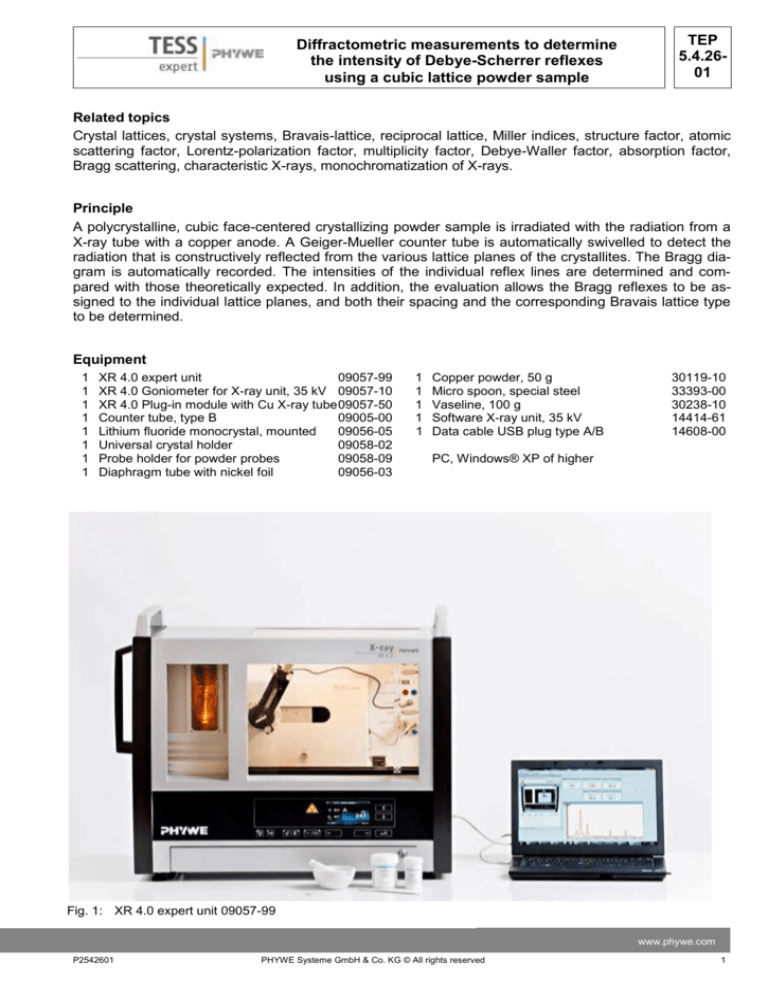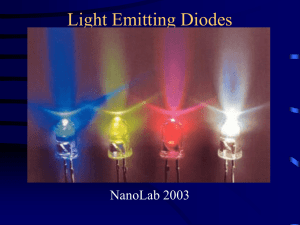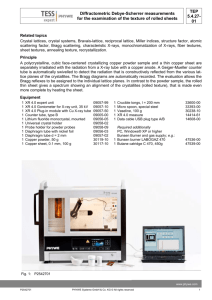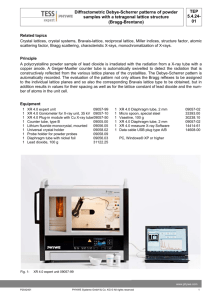
Diffractometric measurements to determine
the intensity of Debye-Scherrer reflexes
using a cubic lattice powder sample
TEP
5.4.2601
Related topics
Crystal lattices, crystal systems, Bravais-lattice, reciprocal lattice, Miller indices, structure factor, atomic
scattering factor, Lorentz-polarization factor, multiplicity factor, Debye-Waller factor, absorption factor,
Bragg scattering, characteristic X-rays, monochromatization of X-rays.
Principle
A polycrystalline, cubic face-centered crystallizing powder sample is irradiated with the radiation from a
X-ray tube with a copper anode. A Geiger-Mueller counter tube is automatically swivelled to detect the
radiation that is constructively reflected from the various lattice planes of the crystallites. The Bragg diagram is automatically recorded. The intensities of the individual reflex lines are determined and compared with those theoretically expected. In addition, the evaluation allows the Bragg reflexes to be assigned to the individual lattice planes, and both their spacing and the corresponding Bravais lattice type
to be determined.
Equipment
1
1
1
1
1
1
1
1
XR 4.0 expert unit
09057-99
XR 4.0 Goniometer for X-ray unit, 35 kV 09057-10
XR 4.0 Plug-in module with Cu X-ray tube 09057-50
Counter tube, type B
09005-00
Lithium fluoride monocrystal, mounted
09056-05
Universal crystal holder
09058-02
Probe holder for powder probes
09058-09
Diaphragm tube with nickel foil
09056-03
1
1
1
1
1
Copper powder, 50 g
Micro spoon, special steel
Vaseline, 100 g
Software X-ray unit, 35 kV
Data cable USB plug type A/B
30119-10
33393-00
30238-10
14414-61
14608-00
PC, Windows® XP of higher
Fig. 1: XR 4.0 expert unit 09057-99
www.phywe.com
P2542601
PHYWE Systeme GmbH & Co. KG © All rights reserved
1
TEP
5.4.2601
Diffractometric measurements to determine
the intensity of Debye-Scherrer reflexes
using a cubic lattice powder sample
Tasks
1. Record the intensity of the Cu X-rays back scattered by a cubic-crystallizing copper powder sample
as a function of the scattering angle.
2. Calculate the lattice plane spacings from the angle positions of the individual Bragg lines.
3. Assign the Bragg reflexes to the respective lattice planes. Calculate the lattice constant of the substance and the Bravais lattice type.
4. Determine the intensity of the individual reflex lines and
compare them with the theoretically expected intensities.
5. Determine the number of atoms in the unit cell.
Set-up
Connect the goniometer and the Geiger-Müller counter tube to
their respective sockets in the experiment chamber (see the red
markings in Fig. 2). The goniometer block with the analyser
crystal should be located at the end position on the left-hand
side. Fasten the Geiger-Müller counter tube with its holder to the
back stop of the guide rails. Do not forget to install the diaphragm in front of the counter tube.
Insert a diaphragm tube with a diameter of 2 mm into the beam
outlet of the tube plug-in unit.
Note
Details concerning the operation of the X-ray unit and goniometer as well as information on how to handle the monocrystals
can be found in the respective operating instructions.
Fig. 2: Connectors in the experiment
chamber
Holder for Powder
samples and universal crystal holder
Counter
tube diaphragm
GM-counter
tube
diaphragm tube
d = 2 mm
Goniometer at the
left end position
Fig. 3: Set-up of the goniometer
2
PHYWE Systeme GmbH & Co. KG © All rights reserved
P2542601
TEP
5.4.2601
Diffractometric measurements to determine
the intensity of Debye-Scherrer reflexes
using a cubic lattice powder sample
Procedure
- Connect the X-ray unit via the USB cable to the
USB port of your computer (the correct port of
the X-ray unit is marked in Figure 4).
- Start the “measure” program. A virtual X-ray unit
will be displayed on the screen.
- You can control the X-ray unit by clicking the
various features on and under the virtual X-ray
Fig. 4: Connection of the computer
unit. Alternatively, you can also change the parameters at the real X-ray unit. The program will
automatically adopt the settings.
- Click the experiment chamber (see the red
marking in Figure 5) to change the parameters
for the experiment. Select the parameters as
shown in the text box.
- If you click the X-ray tube (see the red marking
in Figure 5), you can change the voltage and
current of the X-ray tube. Select the parameters
as shown in the text box: Anode voltage UA = 35
kV; anode current IA = 1 mA..
- Start the measurement by clicking the red circle:
-
After the measurement, the following window
appears:
For setting the
X-ray tube
For setting the
goniometer
Fig. 5: Part of the user interface of the software
-
-
Select the first item and confirm by clicking OK.
The measured values will now be transferred
directly to the “measure” software.
At the end of this manual, you will find a brief
introduction to the evaluation of the resulting
spectra.
Note
Never expose the Geiger-Müller counter tube to
the primary X-radiation for an extended period of time.
Overview of the settings of the goniometer and
X-ray unit:
- 1:2 coupling mode
- angle step width 0.1°
- Scanning range 10°-45°
- Anode voltage UA = 35 kV; anode current
IA = 1 mA
- Scanning speed, when only the very intense
reflex lines are to be recorded, then scanning can be relatively rapid at 10 s/°. For the
identification of weaker lines, a scanning
speed of at least 30 s/° is required for a better signal/noise ratio
www.phywe.com
P2542601
PHYWE Systeme GmbH & Co. KG © All rights reserved
3
TEP
5.4.2601
Diffractometric measurements to determine
the intensity of Debye-Scherrer reflexes
using a cubic lattice powder sample
Sample preparation
The sample must be so finely powdered that no grains can be felt when a little of it is rubbed between
finger and thumb. A relatively high sample concentration can be obtained by mixing the powder with a little vaseline. To do this, transfer a small amount of the sample onto a sheet of paper and use a spatula to
knead it to a firm paste. To achieve the highest concentration of material as possible, use very little vaseline (a spatula tip of it). Fill the relatively solid sample paste into the specimen for powder samples and
smooth it flush. Use the universal crystal holder to hold the specimen.
Calibration of the goniometer with the LiF single-crystal:
Exact angular positions of Debye-Scherrer reflections are only to be expected when the goniometer is
correctly adjusted. Should the goniometer be out of adjustment for any reason whatever, this fault can be
corrected either manually or by means of the autocalibration function:
- Automatic calibration:
The anode material of the X-ray tube is automatically identified. The crystal must be manually set under “Menu”, “Goniometer”, “Parameter”. For calibration, select “Menu”, “Goniometer”, “Autocalibration”. The device now determines the optimal positions of crystal and detector to each other and then
the positions of the peaks. The display shows the corresponding calibration curves. The newly configurated zero position of the goniometer system is saved even after switch-off of the X-ray unit.
- Manual calibration
The crystal for analysis must be manually brought to the theoretical Bragg angle ϑ (counter tube correspondingly to 2ϑ). Now search for the intensity maximum of the line by iterative turning of the crystal
and counter tube by a few ±1/10° around this angular position. Following this and in coupled mode,
bring the crystal and counter tube to the particular zero position corrected by the error value and then
confirm with “Menu”, “Goniometer” and “Set to zero”.
Theory and Evaluation
When X-rays of wavelength λ strike a mass of lattice planes of a crystal of spacing d at a glancing angle
of ϑ, then the reflected rays will only be subject to constructive interference when Bragg’s condition is fulfilled, i.e.:
2d sin n (n = 1, 2, 3, ...)
(1)
The intensity Ihkl of the Bragg reflexes in the Debye-Scherrer powder method is mainly determined by the
following 4 factors:
1. Polarization factor P:
A free electron that is excited by an incident, non-polarized electromagnetic wave emits directionally independent scattered radiation of the same frequency as the primary radiation. The intensity I of the scattered radiation is described by the Thomson formula, whereby 2ϑ is the angle between the primary radiation and the scattered radiation:
IP
1 cos 2 2
2
(2)
2. Lorentz factor L:
According to Bragg’s conditions (equation (1)), only sharp reflex lines at a glancing angle of ϑ should occur. In reality, the reflex ilines exhibit a bell-shaped curve with a maximum and a definite width at half of
maximum intensity. Strictly speaking, however, the line intensity is not determined by the maximum, but
by the area under the curve. This fact and two further factors that take into consideration the statistical
distribution of the crystals in the powder sample and the geometry of the Debye-Scherrer method, are
defined by the Lorentz factor L:
4
PHYWE Systeme GmbH & Co. KG © All rights reserved
P2542601
TEP
5.4.2601
Diffractometric measurements to determine
the intensity of Debye-Scherrer reflexes
using a cubic lattice powder sample
L
1
(3)
4 sin cos
2
On combining both of the above factors, the so-called Lorentz polarization factor LP is obtained:
LP
1 cos 2
sin 2 cos
(4)
As ultimately only relative intensity values are to be compared, the factor 1/8 is generally done without in
equation (4).
3. Structure factor F:
Bragg’s condition implies that all of the waves scattered at the atom are in phase and so amplify each
other, whereas partial waves that are scattered in directions not fulfilling Bragg’s conditions are of opposite phase and so extinguish each other. A more realistic way of looking at this must, however, take the
actual phase relationships of all of the partial waves scattered by the atom in a certain direction into consideration. When there are N atoms in a unit cell, then the total amplitude of the X-rays scattered by the
cell is described by the structure factor F, which is the sum of the atomic scattering factors f of the individual N atoms, taking their phases into account. In general, the following is valid for F:
N
Fhkl f n e 2i hun kvn hwn
1
(5)
where h, k, l = Miller indices of the reflecting lattice planes and un, vn, wn are the coordinates of the atoms
in fractions of the particular edge lengths of the unit cell.
As F is in general a complex number, the total scattered intensity is described by |Fhkl|2.
The atomic scattering factor describes the scattering power of an individual atom and is defined as the
scattering amplitude of an atom divided by the scattering amplitude of a free electron. The atomic scattering factor is dependent on the wavelength and angle, and is given in Tables as (sinϑ/λ) units for each
atom. Fig. 6 shows the course of the value of f as a function of (sinϑ/λ) units for Cu (Z = 29).
𝑠𝑖𝑛𝜗/𝜆
1/𝑝𝑚
Fig. 6: Atomic scattering factor f vs sinϑ/λ
www.phywe.com
P2542601
PHYWE Systeme GmbH & Co. KG © All rights reserved
5
TEP
5.4.2601
Diffractometric measurements to determine
the intensity of Debye-Scherrer reflexes
using a cubic lattice powder sample
In the forward direction (ϑ = 0°), f = Z is true, as in this case all Z-electrons of the atom scatter in phase.
The unit cell of the cubic, face-centered copper lattice has 4 atoms at 000, ½ ½ 0, ½ 0 ½ and 0 ½ ½. As
the Cu lattice only consists of one sort of atom, the following conditions apply for the structure factor according to equation (5):
|F|2 = 16 f 2
with h k l only even or only odd
2
|F| = 0
with h k l mixed
(6)
4. Multiplicity factor M:
When powder samples are examined, the more equivalent lattice planes (lattice planes with the same
spacing d) that belong to an index triplet (h k l), the greater the number of cases in which Bragg’s conditions are fulfilled. With cubic crystals, for example, M100 = 6, because there are 6 cube faces available,
namely h00, 0k0, 00l and the corresponding planes with negative indices. Table 1 shows the multiplicity
factor M for the further low indexed faces of cubic crystals.
Table 1: Multiplicity factor M for the lattice planes of cubic crystals.
hhl
h0l
hh0
hhh
hh0
0kl
0k0
hk0
00l
24
24
12
8
6
When one takes the above factors into consideration in the determination of the intensity I of DebyeScherrer reflex lines, then the following is valid:
I F LP M F M
2
2
1 cos 2 2
sin 2 cos
(7)
The determination of the intensity I acc. to equation (7) is I principle incomplete but sufficient for an estimation, as for a complete determination of the intensity it would be necessary to take absorption and the
effect of thermal vibration of the atoms resulting from the sample temperature (Debye-Waller factor) into
account.
For the cubic crystal system, the spacing d of the individual lattice planes with the indices (h k l) is obtained from the quadratic form:
Die Bestimmung der Intensität I der Reflexlinien nach (7) ist im Prinzip unvollständig aber zum Zwecke
von Abschätzungen ausreichend, denn zur vollständigen Intensitätsbestimmung müssten noch die
Absorption und die Auswirkung der thermischen Schwingungen der Atome aufgrund der
Probentemperatur (Debye-Waller-Faktor) berücksichtigt werden.
Für das kubische Kristallsystem erhält man die Abstände d der einzelnen Netzebenen mit den Indizes (h
k l) aus der quadratischen Form:
1
1
2 h 2 k 2 l 2 (a = lattice constant)
2
d hkl a
(8)
From this and equation (1) with n = 1, the quadratic Bragg equation is obtained:
6
PHYWE Systeme GmbH & Co. KG © All rights reserved
P2542601
TEP
5.4.2601
Diffractometric measurements to determine
the intensity of Debye-Scherrer reflexes
using a cubic lattice powder sample
sin 2
2
4a 2
h
2
k2 l2
(9)
Task 1: Record the intensity of the Cu X-rays back scattered by a cubic-crystallizing copper powder
sample as a function of the scattering angle.
Fig. 7 shows the Debye-Scherrer spectrum of copper (Cu, Z = 29).
As no filter is used for the monochromatization of the X-rays, the fact that the very intense lines resulting
from Kα- radiation are accompanied by secondary lines resulting from the weaker Kβ radiation must be
taken into consideration when individual lines are evaluated.
Such pairs of lines can be identified by means of equation (1). It is namely approximately true with λ (Kα)
= 154.18 pm and λ (Kβ) = 139.22 pm that:
1
2 3
4
5
6
7
8
↓ ↓↓
↓
↓
↓
↓ ↓
9
10
↓
↓
Fig. 7: Debye-Scherrer pattern of a copper powder sample.
www.phywe.com
P2542601
PHYWE Systeme GmbH & Co. KG © All rights reserved
7
TEP
5.4.2601
Diffractometric measurements to determine
the intensity of Debye-Scherrer reflexes
using a cubic lattice powder sample
K sin 154,18 pm
1,11
K sin 139,22 pm
(10)
This value corresponds with the quotients of the sinq values (Fig. 7) of the pairs of lines 2-1, 4-3, 6-5, 9-7
and 10-8, showing that the lines 1, 3, 5, 7 and 8 originate from the Cu Kβ radiation.
The correctness of this conclusion can be shown by a control measurement using the diaphragm tube
with nickel foil to reduce the intensity of the Kβ radiation. The reflexes in Fig. 7 that were previously assigned to the Kβ lines are no longer to be seen. As the intensity of the Kα- radiation is also somewhat
weakened by the Ni foil, the detection of reflexes of weak intensity at larger glancing angles is made difficult when this is used.
Task 2 and 3: Calculate the lattice plane spacings from the angle positions of the individual Bragg lines.
Assign the Bragg reflexes to the respective lattice planes. Calculate the lattice constant of the substance
and the Bravais lattice type.
Table 2 shows the evaluation of the spectrum from Fig. 7.
The glancing angles ϑ found in the experiment and belonging to the individual reflex lines are entered in
column D of Table 2. As it has already been assumed that copper forms a face-centered lattice, only the
permissible hkl triplets for this type of lattice have been taken into consideration in column B. Column G
lists the lattice plane spacings d calculated using equation (1), and column H contains the values of the
lattice constant a calculated using equation (9).
The mean value of a obtained is: a = (361.04 ± 0.52) pm; Δa/a = ± 0,15 %.
(Literature value: a = 361.52 pm).
Table 2: Evaluation of the Kα- and Kβ Debye-Scherrer lines of Cu.
A
Line
1(β)
2
3(β)
4
5(β)
6
7(β)
8(β)
9
10
B
hkl
C
h +k2+l2
D
ϑ/°
E
sinϑ
sin2
111
111
200
200
220
220
311
222
311
222
3
3
4
4
8
8
11
12
11
12
19,54
21,73
22,75
25,29
33,00
37,11
39,69
41,85
45,08
47,65
0,334464
0,370233
0,386711
0,427000
0,544639
0,603347
0,638633
0,667183
0,708093
0,739043
0,111867
0,137073
0,149545
0,182500
0,296632
0,364203
0,407853
0,445133
0,501396
0,546185
2
F
ϑ
G
H
d/pm
208,12
208,22
180,00
180,45
127,81
127,77
109,00
105,33
108,87
104,31
360,48
360,65
360,00
360,91
361,50
361,39
361,61
361,42
361,08
361,34
a/pm
Task 4: Determine the intensity of the individual reflex lines and compare them with the theoretically expected intensities
The individual factors that are necessary for a determination of the intensity have been calculated and
listed in Table 3. Only the Kα- lines were taken into consideration in the evaluation.
Column C shows the glancing angles determined from Fig. 7. Column D contains the values calculated
for (sinϑ/λ) from the Cu Kα- wavelength λ = 154.18 pm. The individual atomic scattering factors fCu were
determined from Fig. 2 using these values (column E). The values for F2 in column F were obtained us-
8
PHYWE Systeme GmbH & Co. KG © All rights reserved
P2542601
TEP
5.4.2601
Diffractometric measurements to determine
the intensity of Debye-Scherrer reflexes
using a cubic lattice powder sample
ing equation (6). Columns G and H contain the values for the multiplicity factor M and the Lorentz polarization factor LP. Finally, the columns I and J show the calculated values for the intensity of the reflex
lines concerned (the line intensity was arbitarily set at 100 here).
Table 3: Determination of the intensities of the reflex lines.
A
Lin
e
2
4
6
9
10
B
hkl
C
ϑ/°
111
200
220
311
222
21,73
25,29
37,11
45,08
47,65
D
sin /
1 / pm
0,240·10-2
0,277
0,391
0,459
0,479
E
fCu
F
F2
G
M
20,4
19,0
15,6
14,2
13,8
6658
5776
3894
3226
3047
8
6
12
24
8
H
1 cos 2
sin 2 cos
2
12,0
8,5
4,5
3,7
2,7
I
J
K
L
Intensity
Calc.
arbitr.
units
6,39∙105
2,95∙105
2,10∙105
2,86∙105
0,66∙105
Relative
Intensity
Calc.
100
46
33
45
10
Intensity
Imp/s
Experiment
230
155
125
155
70
Relative
Intensity
Experiment
100
67
55
67
30
The area under the reflex curve, not the peak height, is decisive for the determination of the intensities of
the reflex lines from the experimental results. The following evaluation procedure is therefore recommended:
Cut out the region around a reflex line using the zoom function for magnification. Mark the region of the
line above the bottom points of the reflex line and onward with the marker (cross symbol on the function
bar) to define the contained area that is to be determined. Activate the intergral function for the area contained by the reflex line. This is then displayed in Imp./s.
The intensities of the individual reflex lines experimentally determined in this way are given in column K.
For a better comparison with the theoretical intensity values, the line intensities standardized on the 111
reflex are given in column L.
Although the comparison of the relative intensity values of the individual reflex lines in columns J and L
do not show exact agreement because absorption and the Debye-Waller factors were disregarded, it is
satisfactorily clear that both theory and experiment indicate that the 111 line is the most intensive line. In
addition, there is the following further agreement between the theoretical and practical results:
1. The 200 and 311 reflexes are equally strong and have the greatest intensity after the 111 reflex.
2. The 220 reflex has an average intensity, whereas the 222 reflex has the lowest intensity.
Task 5: Determine the number of atoms in the unit cell.
Finally, a check is to be made as to whether the unit Cu cell actually does contain 4 atoms as assumed
above.
On dividing the total mass M of a unit cell by its volume V, the density ρ is given, so that:
mA
N a3
M
1
m
n
nm 3
V
N
mA
a mit
(11)
where n = the number of atoms or molecules in the unit cell; m = atomic/molecular mass; mA = atomic/molecular weight; N = 6.022 · 1023 = Avogadro’s number.
Entering the appropriate values for Cu (ρ = 8.92 g·cm-3 and mA = 63.546 g) in equation (11), it follows
that n = 3.98 ≈ 4, i.e. there really are 4 atoms in the unit cell.
www.phywe.com
P2542601
PHYWE Systeme GmbH & Co. KG © All rights reserved
9
TEP
5.4.2601
10
Diffractometric measurements to determine
the intensity of Debye-Scherrer reflexes
using a cubic lattice powder sample
PHYWE Systeme GmbH & Co. KG © All rights reserved
P2542601







